Financial Stability Review – October 2018 5. Assessing the Effects of Housing Lending Policy Measures
Since late 2014, regulators have implemented a suite of policy measures in an effort to mitigate the risks associated with certain forms of housing lending. The Australian Prudential Regulation Authority (APRA) imposed benchmarks on the lending of authorised deposit-taking institutions (ADIs) to investors and to borrowers taking out interest-only (IO) loans. APRA's policy response also included measures to strengthen lending standards, with a greater focus on lending that involves higher risks, including high loan-to-valuation ratios (LVRs) and high debt-to-income lending. In addition, the Australian Securities and Investments Commission (ASIC) increased its scrutiny of lenders' compliance with responsible lending obligations, with a particular focus on the appropriateness of IO lending.
Collectively, these measures have helped to reduce the riskiness of new borrowing. In turn, this has stemmed the increase in household sector vulnerabilities and improved the resilience of the economy to future shocks. The policy measures have required some borrowers and lenders to adjust their behaviour. However, there is little evidence to suggest that the measures have excessively constrained aggregate credit supply or had a significant impact on housing construction or competition for lending. This chapter outlines the policy measures and their impact on the riskiness of housing lending. It also presents quantitative analysis of the effect these measures have had on housing lending and the housing market more broadly.
Policy responded to the increase in housing debt vulnerabilities
In 2014, a growing risk to household balance sheets was judged to be coming from the rapid increase in the share of housing lending to investors, alongside high housing debt that was rising considerably faster than incomes. This followed almost a decade in which household debt had grown broadly in line with income. The strong growth in investor borrowing when prices were rising rapidly was increasing the risk that investor activity could be excessively boosting housing prices and construction and so increasing the probability of a subsequent sharp unwinding. In turn, this constituted a downside risk for economic activity because highly indebted households could sharply reduce their consumption in the event of falls in incomes or house prices.[1] An increase in higher risk and IO housing lending added to the concerns about household balance sheets. The regulatory measures implemented over several years sought to address these risks (Table 5.1). These measures were targeted at the risks surrounding housing lending, not at housing prices.
| Date | Agency | Event |
|---|---|---|
| Nov 2014 | APRA | APRA issues mortgage guidance setting out its expectations for sound residential mortgage lending practices (APG 223). |
| Dec 2014 | APRA |
|
| ASIC | Announces a review of IO residential mortgage lending, focussing on compliance with responsible lending laws. | |
| May 2015 | APRA | Results of the first hypothetical borrower exercise released, covering larger ADIs. The exercise found that serviceability practices had weakened in response to competition and contributed to a program of supervisory action to rectify these practices and a subsequent update of APRA's guidance to ADIs on residential mortgage lending practices. |
| Aug 2015 | ASIC |
Published its review of the IO lending practices of 11 lenders. The report found lenders had not met their responsible lending obligations. In particular, in some cases:
|
| Sep 2015 | APRA |
Results of a follow-up hypothetical borrower exercise released. The exercise found significant improvements in existing serviceability practices resulting from APRA's actions, particularly in relation to:
|
| Sep 2016 | ASIC | Published a review of the lending practices of 11 large mortgage brokers in relation to IO loans. It identified good practices as well as opportunities to improve brokers' practices. |
| Feb 2017 | APRA | Amendments to Prudential Practice Guide APG 223 finalised. These focused on prescribing minimum standards for serviceability practices as highlighted by APRA's hypothetical borrower exercises. |
| Mar 2017 | APRA |
|
| Mar 2017 | ASIC | Published a review of the effect of remuneration structures in the mortgage broking market on the quality of consumer outcomes in response to a request from the Australian Government in November 2015. The review found that neither lenders nor brokers made sufficient inquiries into consumers' living expenses and that broker-originated loans were more likely to be larger loans and have IO periods. |
| Apr 2017 | ASIC | Announced the findings of a review of the practices followed by eight lenders when making inquiries about borrowers' living expenses. As a result, these lenders committed to provide remediation to borrowers who suffer financial difficulty as a result of shortcomings in past lending practices. ASIC also announced it had begun examining whether lenders and mortgage brokers were recommending IO loans in appropriate circumstances. |
| Apr 2018 | APRA |
Announced the removal of 10 per cent investor benchmark from July 2018 on an ADI-by-ADI basis, provided that:
ADI boards were also asked to set limits on residential lending with debt-to-income (DTI) ratios exceeding six. |
|
Sources: APRA; ASIC; RBA |
||
The measures focused on lending that had greater potential risk for borrowers, lenders and the economy more broadly. High LVR loans pose risks to borrowers and ADIs because of the relatively small equity buffers available to absorb property price falls. IO loans can also be riskier for borrowers and lenders as the loan amount does not need to be paid down during the IO period. Investor loans have not historically had higher default rates than owner-occupier loans, at least when economic conditions are benign. However, these loans may prove to be at greater risk of default in an economic downturn. Further, investor lending poses risks to the financial system to the extent that it can amplify housing price cycles.[2] Changes to loan serviceability assessment practices were critical in strengthening the overall quality of lending and providing greater consistency in serviceability risk assessment across ADIs. These changes resulted in reductions in maximum potential loan sizes offered by many ADIs, although actual loan sizes were mainly only constrained for higher risk borrowers. Notably, although the measures did not directly target the overall amount of household debt or the rate of growth in house prices, they may have had some effect on both.
Lenders changed their interest rates in response to the policy measures
In order to meet the investor and IO benchmarks, lenders chose to reduce the number of these types of loans demanded by increasing their interest rates on these products. Before this, the loan purpose or repayment type was typically not factored explicitly into loan pricing decisions. Advertised interest rates were the same for owner-occupier and investor loans, and for IO and principal and interest (P&I) loans. However, lenders did differentiate their interest rates based on other factors such as the size of the loan and borrower characteristics.
Lenders did not begin to adjust their pricing in response to the investor benchmark until around six months after the December 2014 announcement (Graph 5.1). Initial attempts to meet the benchmark by adjusting non-price measures such as lending standards proved to be insufficient, with the rate of investor credit growth remaining high until pricing changes were made. Initially, lenders increased their advertised interest rates by around 25 basis points. Following the March 2017 announcement by APRA, which reinforced the investor benchmark and also introduced the IO benchmark, ADIs once again increased their interest rates on investor loans. Data from the Reserve Bank's Securitisation Dataset demonstrate that these changes in advertised rates flowed through to the rates actually paid by borrowers, which include any discounts received. Variable interest rates on outstanding investor loans were on average around 10 basis points lower than those on owner-occupier loans before the benchmark, but by mid 2017 they had increased to be around 50 basis points higher.
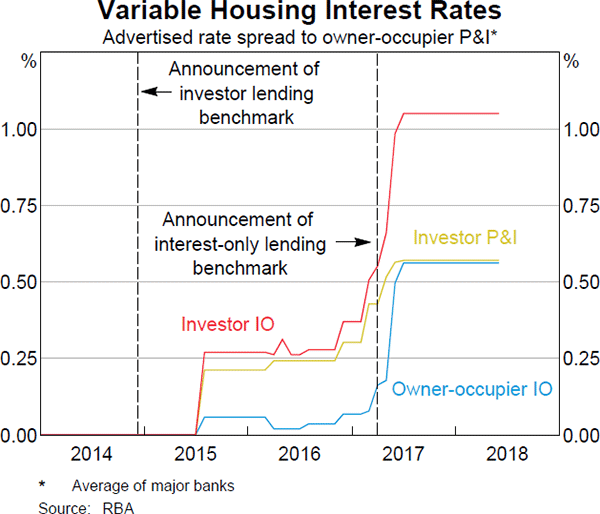
ADIs responded more quickly to the announcement of the IO benchmark in March 2017. Advertised interest rates on IO loans increased by around 50 basis points relative to those on P&I loans. This increase applied to both owner-occupier and investor IO loans, resulting in advertised interest rates on investor IO loans currently being around 1 percentage point higher than those on owner-occupier P&I loans. Average interest rates on outstanding IO loans are now around 40–50 basis points higher than equivalent P&I loans.
Most ADIs chose to increase their interest rates on both new and existing loans. The investor benchmark applied to the growth of each ADI's total investor lending. Banks argued that increasing the interest rate for existing borrowers could help to meet this objective as it could encourage borrowers to repay their existing loans more quickly. In contrast, the IO benchmark was designed to apply to the flow of new IO loans, and so changes in the stock of existing IO lending did not help a lender to meet the benchmark. The Productivity Commission has raised concerns about the implications for competition of lenders' decisions to reprice existing IO loans.[3] Notably, however, the imposition of the benchmarks does appear to have caused ADIs to reassess the risks involved with some types of loans and so the composition of lending they feel comfortable with. The 2017 increases in interest rates on investor and IO loans also broadly coincided with announcements from APRA regarding future increases in capital requirements for these types of lending. Given that any changes to capital requirements would apply to both new and existing loans, this may have also influenced lenders' decisions to reprice their existing investor and IO loans. As a result, it may be that some differential in loan pricing remains even with the progressive removal of the investor benchmark from July 2018.
The risk profile of new lending has improved since the measures were introduced
The rate of growth in investor credit slowed significantly after the investor growth benchmark was introduced (Graph 5.2). Investor credit growth initially only slowed slightly after the announcement. But from mid 2015 when ADIs increased their interest rates for investors, investor credit growth slowed sharply.[4] The tightening in serviceability standards, in particular the interest rate buffer requirements, as well as APRA's announcements in March 2017, are also likely to have slowed investor credit growth. In contrast, the rate of growth in owner-occupier credit has picked up since late 2014, in part reflecting lenders' competition for these borrowers. This has resulted in a noticeable shift in the composition of housing credit growth, but only a relatively modest decline in the overall rate of growth.
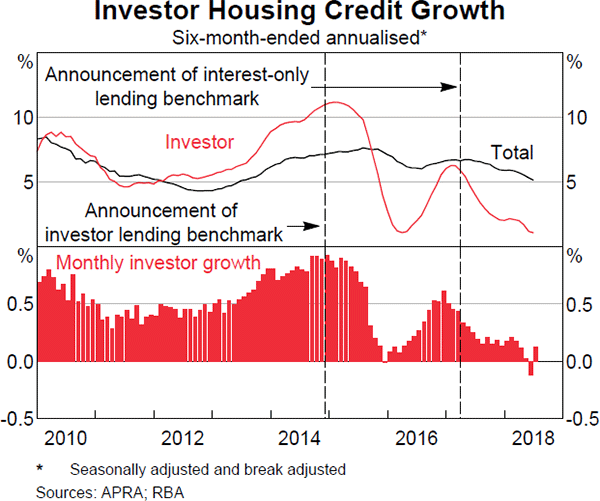
The introduction of the IO benchmark and resulting increase in interest rates on IO loans prompted a sharp decline in IO lending. The aggregate IO share of new loan approvals fell from almost 40 per cent of the total value of approvals in the March quarter of 2017 to around 15 per cent in the June quarter of 2018 (Graph 5.3). Although the interest rate premium for IO loans relative to P&I loans was similar for investor and owner-occupier loans, the decline in the IO share was more pronounced for investors than it was for owner-occupiers. This suggests investors are more price sensitive than owner-occupiers, presumably because they typically base the decision to have an IO loan on the cost benefits flowing from interest deductibility. In addition, because ADIs increased their interest rates on existing IO loans, many existing borrowers switched to P&I loans and were often encouraged to do so by their lender. This, coupled with the declining share of IO approvals, has resulted in a substantial fall in the IO share of outstanding loans. The IO share of outstanding loans is likely to decline for some time yet, as older IO loans transition to P&I repayments (IO loans typically have an interest-only period of around five years).
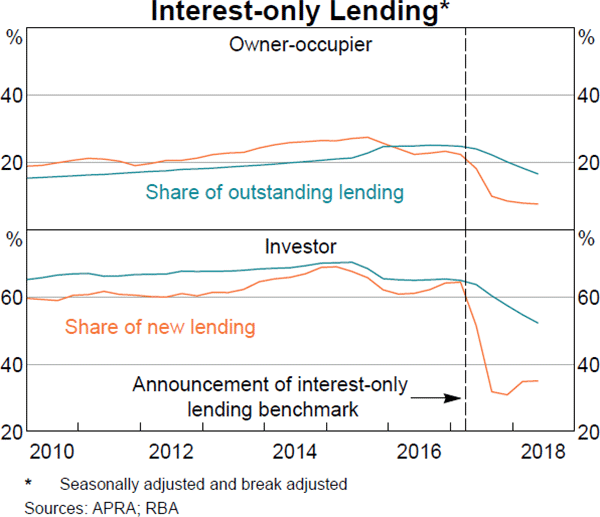
The share of new housing loans approved with very high LVRs (greater than 90 per cent) has declined since APRA strengthened its guidance to ADIs on high risk lending in late 2014 (Graph 5.4). However, the share of very high LVR loan approvals had been declining for owner-occupier loans for some time before the announcement, reflecting a combination of increased supervisory focus on higher-risk lending and changes in risk appetite at some ADIs.
Through its supervision process and updates to prudential guidance, APRA promoted stronger loan serviceability assessment practices in 2014 and 2015. These included establishing minimum expectations for interest rate buffers (including on a loan applicant's existing debt), the amortisation of IO loans after the IO period expires, ‘haircuts’ applied on rental and less stable types of income and measurement of household expenses. These changes reduced the maximum loan size available to many borrowers at many ADIs. In practice, most borrowers take out a smaller loan than the maximum that a lender might offer, which means the aggregate effect of these measures on credit supply is small (See ‘Box B: The Impact of Lending Standards on Loan Sizes’). While the share of borrowers who take a loan near their maximum and so would have been affected by the changes is generally small, the extent to which borrowers are constrained will depend on their individual characteristics. For example, the impact on aggregate new borrowing of introducing income-adjusted benchmarking of borrowers' expenses depends on the distribution of income of prospective borrowers. Similarly, the impact of more stringent treatments of rental or irregular sources of income in serviceability assessments only affects investors and borrowers that rely on these income sources. Previous analysis undertaken by APRA quantified the impact of tighter lending standards for four ‘hypothetical’ borrowers and found that maximum, not actual, loan sizes declined by 12 per cent, on average, for investors and by 6 per cent, on average, for owner-occupiers between 2014 and 2015.[5] Because of the many differing components of the tightening in lending standards, and that their impact depends on previous lender practices (which differed significantly across lenders) and individual borrower characteristics, it is difficult to quantify the impact of these measures precisely.
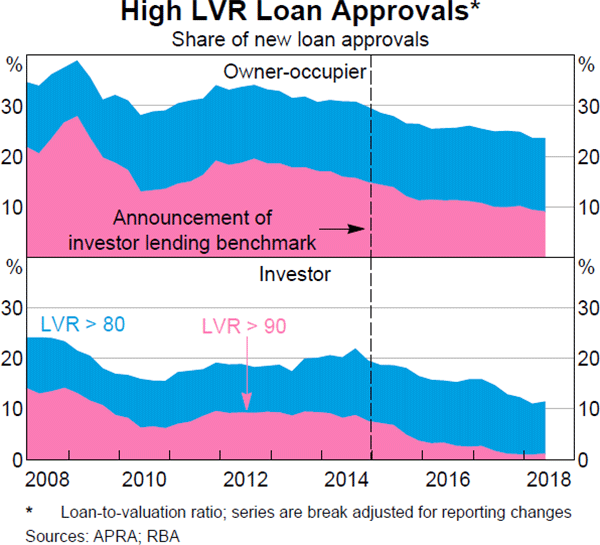
Evidence suggests that the investor benchmark directly altered the composition of new lending
Quantitative analysis by the Bank provides strong evidence that the investor benchmark was effective in changing the composition of new lending. This analysis compares new housing lending by individual ADIs to investors and owner-occupiers before and after the imposition of the benchmark. Using data for individual ADIs helps to identify the policy impact because it assists in controlling for the range of other non-policy related factors that also influenced the demand for, and supply of, new lending, such as broader economic conditions at the time. Because several complementary measures were introduced within a relatively short period, the analysis is undertaken for the 2014 announcement as, in contrast to the 2017 IO announcement, the preceding period is not influenced by other substantive policy measures.
The impact on new lending is estimated by comparing each ADI's actual loan approvals following the 2014 announcement with a ‘counterfactual’ amount of loan approvals. The counterfactual approvals are an estimate of what each ADI's new lending would have been in the absence of the policy. It is estimated based on the historical relationship between loan approvals reported by each ADI and a number of ADI-specific factors that may influence their supply of credit along with aggregate demand factors (using a regression).[6] The supply-side factors are ADI assets, the deposit share of funding, the liquid asset share of total assets and Tier 1 capital ratios. The demand-side factors are the cash rate, the rate of growth in real GDP, and changes in housing prices.[7] The analysis includes lags to account for any delay by ADIs in changing their lending. Any systematic difference in the relationship between the counterfactual and actual loan approvals before and after the policy announcement provides an estimate of the impact of the policy measure.
The December 2014 investor announcement is estimated to have reduced the amount of new investor loan approvals by around 13 per cent in the four quarters following the announcement. This is equivalent to around 3 per cent of total outstanding investor credit at the time (Graph 5.5). However, it is also estimated that the announcement induced an increase in new owner-occupier loan approvals at some ADIs. The increase in owner-occupier loan approvals likely reflects a combination of factors. In reducing investor demand, the benchmark may have provided more opportunities for owner-occupier purchases. Also, some ADIs may have refocused their efforts on growing their owner-occupier housing lending portfolios given the constraints imposed on their housing investor lending growth. The net effect is estimated to have been virtually no change in the flow of total (investor plus owner-occupier) loan approvals in the four quarters following the announcement. This supports the assessment that the December 2014 policy prompted changes in the composition of lending at many ADIs, but did not lead to outright reductions in new lending.
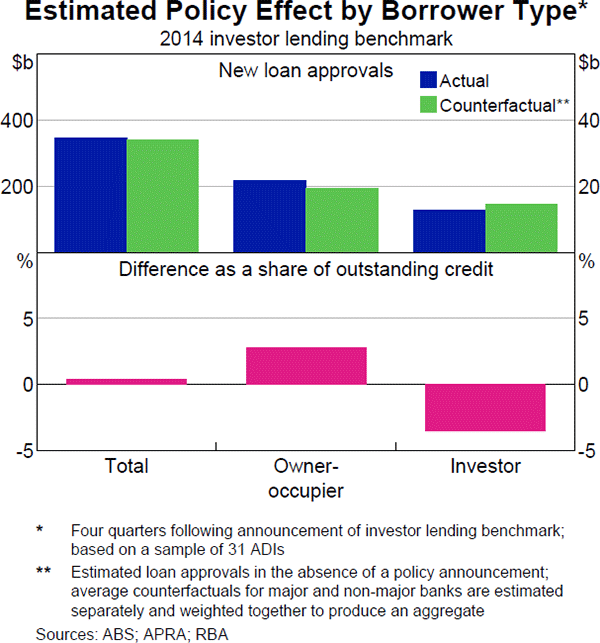
The measures had some impact on competition but it does not seem to have been permanent
The imposition of the investor benchmark appears to have constrained the gain in market share of some smaller ADIs and so diminished competition among lenders for some time. A constraint on an assessment of the impact of the benchmark on market share is that a number of lenders reclassified a greater-than-usual amount of their existing loans from investor to owner-occupier products around the same time. To avoid these, and any other, reporting changes driving market share trends, this section uses break adjusted lending data generated for the Reserve Bank's credit statistics. It is important to note that these are not the same data used by APRA to monitor compliance with the benchmark.
When the investor credit benchmark was imposed, aggregate investor credit growth was a bit over 10 per cent, but some institutions were growing substantially faster than this and gaining market share. In particular, a small number of non-major ADIs had collectively gained around 1½ percentage points of market share between 2012 and mid 2015 based on (the adjusted) outstanding investor loans (Graph 5.6). Constrained to grow their investor credit at less than 10 per cent per year, these institutions were limited in their ability to increase their market share after the benchmark was introduced. In contrast, these same ADIs continued to gain market share for owner-occupier credit, albeit at a somewhat slower rate than previously, suggesting that it was the investor benchmark that was largely responsible for constraining their investor credit growth rather than ADI-specific factors. However, the market share of other non-major ADIs that had been declining before the benchmark did not continue to fall following its introduction. Based on the adjusted lending data, the investor market share of the major banks had been stable before the investor benchmark, but increased after the benchmark was imposed. However, it is notable that, without adjustments for data reporting changes, the major banks' share of the investor lending market declined immediately after the investor benchmark was introduced. This seemingly reflects major banks being more likely than other ADIs to reclassify their existing investor loans as owner-occupier products in late 2015.
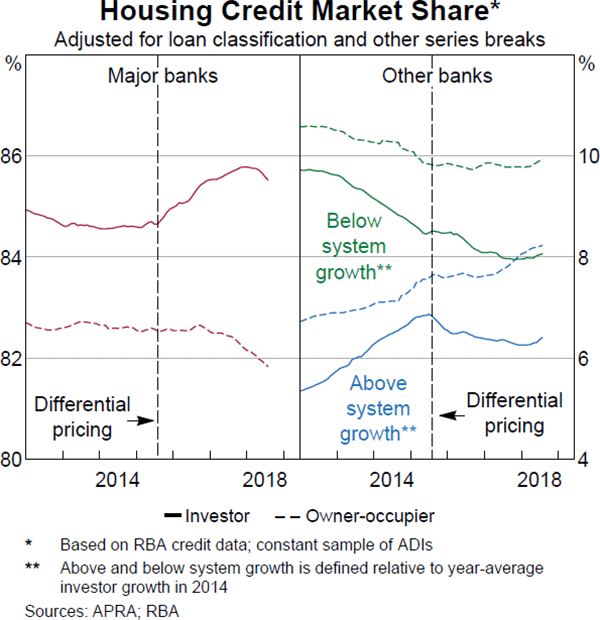
In any case, with aggregate year-ended investor credit growth declining from 5 per cent to less than 2 per cent over the past year and most individual ADIs' investor credit growth well below 10 per cent, the benchmark has not been a significant constraint on most ADIs growing their market share for some time. Indeed, the earlier trends apparent in investor credit market share appear to have resumed over the past year, with some of the smaller ADIs once again gaining market share from the major banks.
The IO benchmark had little effect on competition between lenders. The IO benchmark applied to the share of new loans at each ADI that were interest only, meaning lenders could continue to compete aggressively for new IO loans if they were also competing aggressively for non-IO lending. The aggregate share of new IO lending has declined to 17 per cent with many lenders even further below the 30 per cent benchmark. This suggests many lenders have ample capacity to increase their IO lending. That they have not suggests that ADIs have reassessed what they consider to be a prudent IO lending share.
There has been some tightening in credit availability, although the overall impact appears moderate
A notable concern about the policy measures is that they could result in a significant tightening in credit availability. In a severe scenario, this could lead to a slowdown in economic activity and housing markets and so have adverse consequences for financial stability. However, as discussed in detail in ‘Box B: The Impact of Lending Standards on Loan Sizes’, only those most risky borrowers have actually been constrained by the tightening in lending standards, as most borrowers take out loans well below the maximum that are offered by lenders. Indeed, those borrowers are the most likely to experience repayment difficulty. So the impact of the measures on the aggregate quantity of credit supplied has been relatively moderate. Rather, the dominant effect of the measures has been to improve the quality or composition of housing lending.
However, the tightening in lending conditions disproportionately affects some prospective and existing borrowers and so could result in some adverse outcomes for them. A tightening in the supply of IO loans will have prevented some borrowers with IO loans from extending their IO period and required them to switch to higher P&I payments. Although this ‘repayment shock’ effect should be mitigated by a range of factors, a small share of borrowers could encounter financial stress.[8] Liaison with ADIs suggests that some borrowers have encountered repayment difficulties after switching to P&I repayments at the end of their IO terms, but that many have subsequently been able to adjust to higher payments within a year. Loan level data from the Reserve Bank's Securitisation Dataset supports this. The share of loan balances that are between 30 and 90 days behind in their repayments increases within three months of switching. But this share declines to close to its pre-switching level within a year (Graph 5.7).[9] While it appears that the share of loan balances more than 90 days in arrears has increased for loans that switch to P&I at the end of their IO period, this is likely to partly reflect the lower credit quality of loans switching at the end of their IO period. In contrast, the borrowers that choose to switch before the end of the IO period exhibit very low arrears rates, both before and after switching.
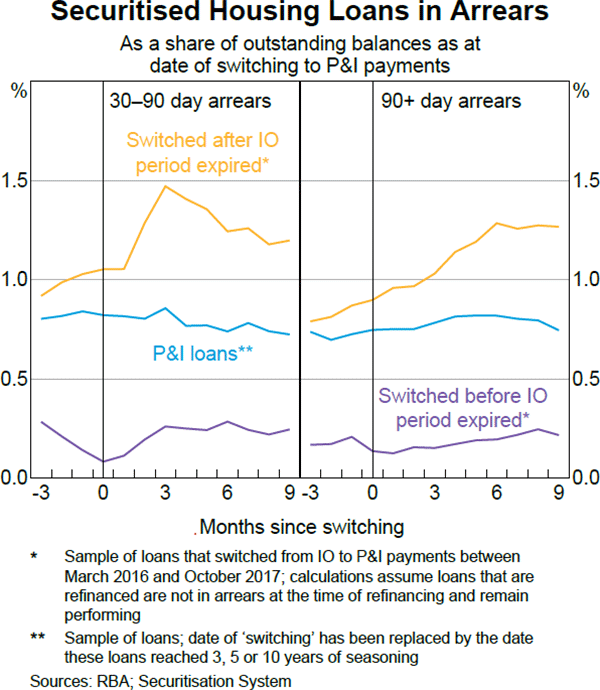
Lending by non-ADIs has increased
The tighter lending conditions have encouraged some borrowers to obtain finance from non-ADI lenders, in particular, prospective borrowers who were offered smaller maximum loan sizes or unable to obtain finance from ADIs. Given that non-ADIs are subject to less regulatory oversight, this could increase financial stability risks. Non-ADIs' housing lending has been growing rapidly, over twice the rate of growth of ADIs. An alternative measure of their growth comes from their funding – which mostly comes from residential mortgage-backed securities (RMBS). Quarterly issuance of RMBS has averaged around $4 billion over the past two years, which is more than double its average over the previous five years (though still well below its pre-crisis levels) (Graph 5.8). The estimated non-ADI share of housing credit has also increased, although it remains low at less than 5 per cent of the total. Non-ADI lending is therefore unlikely to lead to systemic risks at its current level. If non-ADI lenders were at some future time to pose a material risk to financial stability, APRA now has the ability to invoke its reserve power to impose regulations on these lenders in order to manage these risks.
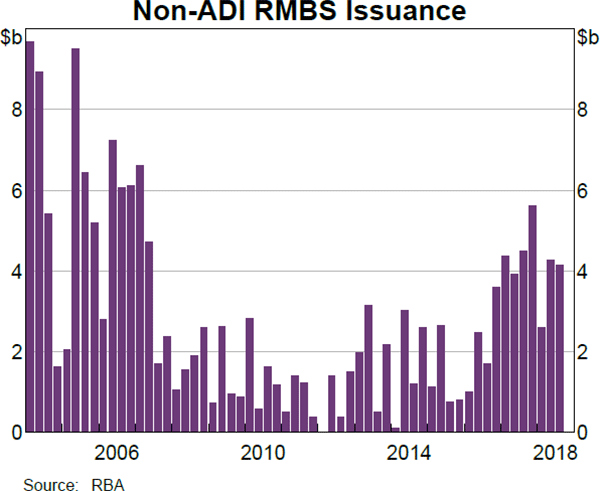
The tightening of credit supply affected housing market conditions in some regions
The close relationship between debt and housing prices means that the policy measures targeting housing borrowing are likely to have influenced housing market conditions. As discussed in the ‘Household and Business Finances’ chapter, housing prices have eased since late 2017, particularly in Sydney and Melbourne. The easing is consistent with a broad range of factors, including increased supply and moderating demand given the high level of prices, but there is evidence that the prudential measures also played some part.
While each of the measures set out in Table 5.1 is likely to have had some effect, the 2014 investor benchmark is analysed in this chapter as it was not preceded by other substantial measures that would have been already affecting housing market outcomes. One simple way to gauge the policy effect is to examine the relative performance of housing prices in regions that are likely to have been more heavily affected by the investor benchmark (‘high investor regions’) to those that are likely to have been less affected (‘low investor regions’). The high and low investor regions are defined based on the share of investor-owned dwellings in each region before the policy measure.[10] The high investor regions are those in which the share of investor-owned dwellings is in the top 25 per cent of the nationwide distribution. The low investor regions are those where the share of investor-owned dwellings is in the bottom 25 per cent of the nationwide distribution.
The difference in housing price growth in the high and low investor regions following the policy measures suggests there was an impact on housing price growth. The average price growth in these two groups was very similar in the lead-up to the investor lending benchmark, but since then, the high investor regions have experienced notably slower price growth than the low investor regions (Graph 5.9). Note that this analysis implies the policy measure affected the relative prices between regions, but it does not indicate whether there was an effect on overall housing prices. The stronger performance of low investor regions, which by definition have more owner-occupiers, could in part reflect the increase in owner-occupier credit growth.
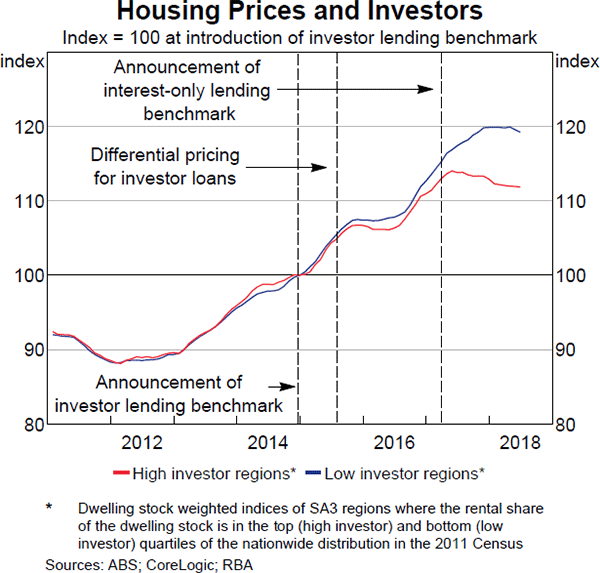
The divergence in price growth began to open up around one year after the announcement of the investor benchmark. This was shortly after the introduction of differential pricing for investor loans. It widened further around the time of the March 2017 announcement of the IO benchmark (and reinforcement of the investor benchmark).
This evidence suggests that the investor benchmark led to an easing in housing price growth. But, other factors may have also contributed to the divergent price growth between the high and low investor regions. For example, regions with a high share of investors may have also experienced larger increases in housing supply and so slower price growth in the period after the benchmark was introduced.
To better isolate the impact of the policy measure, it is important to control for as many other factors influencing regional housing prices as possible. In addition to the differences by region in the investor share of dwellings, other potential explanatory factors include location-specific characteristics such as the location, population density and geographic size of each region, and market-specific characteristics such as the rate of increase in residential building approvals and the rate of housing price growth in the lead-up to the investor benchmark announcement. After controlling for these other factors (using a regression), it is possible to obtain a better estimate of the effect of the investor benchmark on prices.[11],[12] In practice, the estimated ‘investor share (or ‘policy’) effect’ will also partly reflect the effect of the IO benchmark, since IO lending was more common in high investor regions than in low investor regions. If anything, the restrictions on high LVR lending will have worked in the other direction by reducing the estimated investor share effect since high-LVR loans are more common among owner-occupiers than investors.
This approach enables the difference between the housing price growth outcomes of the high and low investor share regions to be separated into that part due to the policy measure and that part due to other factors (Graph 5.10).[13] This exercise suggests that the policy effect accounts for around two-thirds of the 7 percentage point difference in average cumulative housing price growth between high and low investor regions from December 2014 to mid 2018.
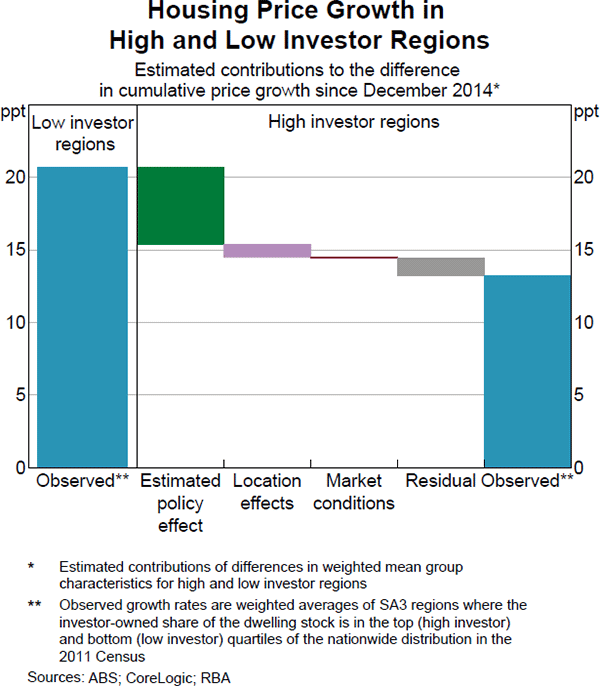
Construction activity has remained strong, but the policy measures could contribute to a slowdown
Housing construction, in particular higher density building, has risen to a high level in recent years, and the pipeline of work yet to be done also remains high (Graph 5.11). Construction activity has been supported by strong population growth, low interest rates and encouraged by higher housing prices. An increased share of construction in recent years has been of higher density dwellings, a large share of which are purchased by investors. Off-the-plan sales are an important determinant of developers' ability to obtain finance to undertake construction.
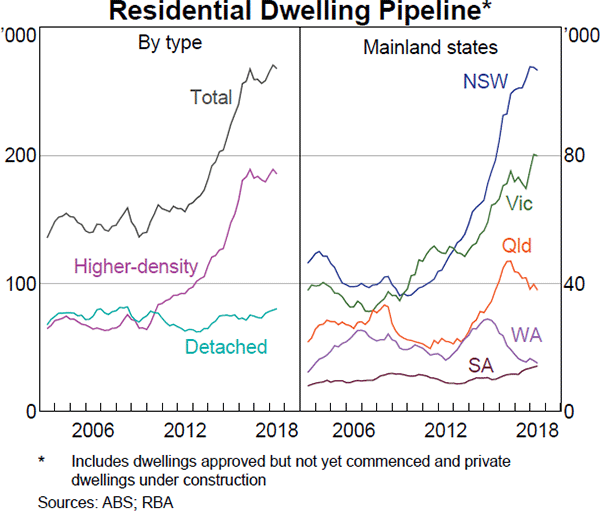
However, construction activity is slowing as the large increase in supply meets demand with housing prices no longer rising. While this is not unlike past housing cycles, the reduction in investor borrowing and demand, along with tighter lending standards, have contributed, at least in part. Off-the-plan apartment sales in the major east coast cities have declined since around mid 2017, with developers citing weaker demand from domestic investors, as well as from foreign buyers. One risk is that tighter lending standards could amplify the downturn in apartment markets if some buyers of off-the-plan apartments are unable to obtain finance. This could lead to an increase in settlement failures, further price falls and even tighter financing conditions for developers. However, to date, there is little evidence of this.
While not directly related to the housing measures, there has been some tightening in credit availability for developers of residential property. This reflects lenders' desired exposure to dwelling construction, which is higher risk lending, particularly given the longer planning and construction lags of higher density dwelling construction. To the extent that the housing policy measures have contributed somewhat to the decline in investor demand and prices, they have indirectly affected developers' access to finance.
Overall, the policy measures have helped reduce financial stability risks
The policy measures were conceived in an environment of rising risks to the economy and financial system from housing lending. The riskiness of new borrowing was increasing against a backdrop of high and rising household debt relative to income. Since the measures were introduced, the composition of new lending has changed toward less risky types of loans. Tighter lending standards and the reduction in high LVR lending has resulted in a smaller share of new lending going to households that are more likely to struggle to repay their debt. The change in the composition of new debt has been rapid, with smaller shares of investor, interest-only and high LVR lending. Over time, the risk profile of the existing stock of debt has improved and will continue to do so as a greater share of outstanding loans have been written under more stringent lending standards.
While the policy measures have affected the composition of new lending, they have had less impact on the aggregate quantity of new lending. Evidence focusing on the 2014 investor benchmark shows this policy resulted in a marked decline in investor lending relative to owner-occupier lending, but had little direct impact on total housing credit growth. Since the investor benchmark constrained the growth of all ADIs' investor credit this had an effect on competition among lenders, but this does not appear to have been permanent. There is also evidence that, by affecting the composition of lending, the measures have influenced housing market conditions in those regions that were most affected by the change. In dampening investor demand, the measures are likely to have affected housing prices and construction dynamics in some locations, and so likely been stabilising for the housing market over the longer run. However, the measures have likely only had a moderate effect on aggregate housing prices given the evidence that at least the investor measure did not affect aggregate credit growth.
Overall, the available evidence suggests that the policies have meaningfully reduced vulnerabilities associated with riskier household lending and so increased the resilience of the economy to future shocks. However, the overall stock of household debt is high relative to income, suggesting that the associated risks remain.
Footnotes
See, for example, RBA (2014), Financial Stability Review, September. [1]
See RBA (2017), ‘Box B: Households' Investment Property Exposures: Insights from Tax Data’, Financial Stability Review, October, pp 26–28. [2]
Productivity Commission (2018), ‘Competition in the Australian Financial System’, Inquiry Report, No 89, June 2018. [3]
In addition to discouraging some new investor lending, the increase in the interest rate premium on investor loans prompted some reclassification of existing loans that had previously been recorded as investor, rather than owner-occupier mortgages. Many of these loans had likely switched purpose at some earlier date, but the introduction of a pricing differential provided greater incentive for borrowers to report the change. The investor credit growth measures referred to in this chapter abstract from the effect of this reporting change. For more information, see RBA (2018), ‘Box D: Measures of Investor and Owner-occupier Housing Credit’, Statement on Monetary Policy, February, pp 52–53. [4]
The hypothetical borrower exercise asked lenders to provide maximum loan sizes and details of the net income surplus calculation (surplus household income after expenses and prospective loan repayments) for four potential borrowers, two owner-occupiers and two investors. These borrowers varied by income, property price, family structure, expenses, other debts and the type of loan they were requesting. See Richards H (2016), ‘A prudential approach to mortgage lending’, Speech at Macquarie University Financial Risk Day, Sydney, 18 March. [5]
A detailed description of this analysis is available by contacting the Reserve Bank. It is based on a sample of 31 ADIs with housing loan assets of more than A$1 billion over the relevant analysis period. The policy effect is measured over the four quarters following the announcement. While loan approvals will differ from actual new lending (some approvals will not translate directly into loan originations), the difference is likely to be small, and unaffected by the policy change. [6]
Most of the demand and supply control variables are lagged by one quarter to mitigate endogeneity issues. [7]
Mitigating factors are discussed the RBA (2018), Financial Stability Review, April and in Kent C (2018), ‘The Limits of Interest-only Lending’, Address to the Housing Industry Association Breakfast, Sydney, 24 April. [8]
The Securitisation Dataset covers around a quarter of the residential mortgage market by value. The estimates presented in this chapter are based on a somewhat smaller share, as the sample has been trimmed in order to abstract from a number of reporting issues. [9]
Census data are used to calculate the share of rental properties in each region, which is taken to be the share of the dwelling stock owned by investors. Although dated, the 2011 data provide the best estimate of high investor regions prior to the implementation of the policies (whereas the 2016 data will have been affected by the policy measure and therefore not allow the policy effect to be identified). [10]
The accuracy of this estimate will depend on (i) whether there are other important causes of post-policy housing price growth across regions that are correlated with the investor share of dwellings but which are not able to be explicitly controlled for and (ii) the extent to which the other control variables are correlated with the investor share variable. [11]
A detailed description of this analysis is available by contacting the Reserve Bank. The analysis is based on a cross-sectional SA3 region-level dwelling stock weighted regression of cumulative growth in hedonic housing price indices in the post-investor benchmark period (42 months since December 2014) on: price growth over the 42 months before the benchmark; the share of dwellings rented in 2011; dwelling approvals as a share of the dwelling stock in 2014; the natural logarithm of the region size; the number of people per square kilometre; and dummy variables for each ABS SA4 region. [12]
This is done by calculating the difference in the average value of each of the explanatory variables for regions in the ‘high investor’ and ‘low investor’ regions. The coefficients from the regression are then applied to these differenced explanatory variables to decompose the observed difference between the average housing price growth rates in the high and low investor regions. [13]